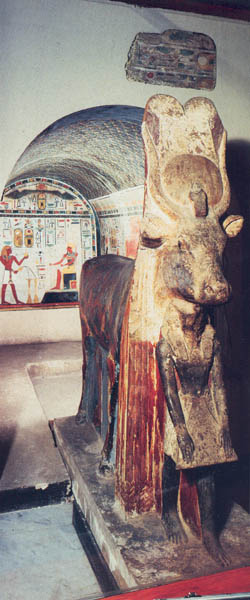Image Details

Verlag Philipp Von Zabern/Photo by Jurgen Liepe
Two Egyptian deities, Hathor, in the form of a cow (foreground), and Amon-Re (seated, on far wall). This scene was discovered at Deir el-Bahari in 1906 and dates to the beginning of the reign of Amenophis II, about 1440 B.C. The new pharaoh, successor to Tuthmosis III, stands protected beneath Hathor’s horned head; his name is inscribed on her neck. On the far wall, Tuthmosis III pours a libation to Amon-Re.
In recounting the Exodus from Egypt, Numbers 33:4 declares, “The Lord executed judgments against their gods.” “Their gods” means the gods of Egypt and suggests that the Ten Plagues—the prelude to the Exodus—were attacks on particular Egyptian gods.
Following this line of argument, Hathor, the mother and sky goddess who was typically depicted as a cow, was the target of the fifth plague, the pestilence that afflicted animals. (Alternatively, the target may have been Apis, a fertility god, who was represented as a bull.) Amon-Re, king of the gods and patron of the pharaohs, was one of several Egyptian gods associated with the sun. He or one of the others may have been intended as the target of the ninth plague, darkness.
One problem with this interpretation of the plagues is that there are no suitable Egyptian gods to match with the third, fourth and sixth plagues—lice, flies and boils. Further, those gods that dovetail with the plagues may not have been worshipped in Egypt’s Western Delta during the 14th through 12th centuries, when the Israelites would have been exposed to them.
